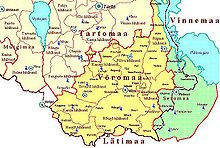Võro
| Võro (võro kiiĺ) | ||
|---|---|---|
|
Spoken in |
Estonia | |
| speaker | 70,000 (native speakers) | |
| Linguistic classification |
|
|
| Language codes | ||
| ISO 639 -1 |
et (Estonian) |
|
| ISO 639 -2 |
est (Estonian) |
|
| ISO 639-3 |
vro (Võro), est (macro language, Estonian) |
|
Võro (võro kiiĺ) is traditionally a dialect of Estonian . However, some authors also speak of an independent Finno-Ugric language, South Estonian , which belongs to the Baltic Finnish branch of the Finno-Ugric languages. Võro is now promoted by the Estonian state as an indigenous regional language of Estonia and has around 70,000 speakers, mainly living in southern Estonia.
The historic Võromaa consists of the eight municipalities Karula , Harglõ , Urvastõ, Rõugõ, Kanepi , Põlva , Räpinä and Vahtsõliina. These parishes are predominantly parts of Võru and Põlva counties , with small parts also extending into Valga and Tartu counties .
history
Võro is considered to be the least influenced by the North Estonian dialects that shaped Standard Estonian. Võro used to be spoken south and east of historical Võromaa (in what is now Latvia and Russia ). Compared to other South Estonian dialects such as Mulgi , Tartu and Seto , Võro has retained most of its distinctive features.
One of the earliest texts in any South Estonian language is a translation of the New Testament (Wastne Testament) published in 1686. In 1885 Johann Hurt published the most important reading book in Võro, the Wastne Wõro keeli ABD raamat . At the beginning of the 20th century, the dominance of Standard Estonian as the state language of the Republic of Estonia, which was founded in 1918, resulted in a significant loss of importance for Võro as a written language. It was not revived until the early 1990s.
Current situation
Due to the efforts of the Võro Institute , Võro is now standardized. The language is taught in 26 schools. There with Uma Leht a bimonthly newspaper in Võro.
orthography
Võro uses a Latin alphabet (like Estonian and Finnish) . Most of the letters (especially ä, ö, ü and õ) refer to the same sounds as in standard Estonian. The following letters, which are rarely used in Standard Estonian , stand for other sounds: q is a glottal sound, y is a vowel similar to Russian ы , and the acute ´ denotes the palatalization of consonants : h́ , ḱ , ĺ , ń , ś , t́ etc. For typographical problems (as in Uma Leht ), an apostrophe ' can be used instead of the acute accent .
In the Võro all consonants except j and q can be palatalized.
Differences from standard Estonian
- In Võro, as in the Finnish and many other Urural languages or the Turkish language as a non-Ural language, there is the phenomenon of vowel harmony .
- There are differences in morphology . For example, the standard Estonian forms the 3rd person singular by adding the ending -b to the inflection stem, while Võro either by leaving out an ending or adding the ending -s:
| German | Estonian | Võro |
|---|---|---|
| he writes | kirjuta b | kirota s |
| he gives | anna b | other |
Among the Baltic Finnish languages, such a double verb conjugation is only found in Võro, Setukesian and Karelian .
- There are also differences in some words from everyday language:
| Estonian | Võro | meaning |
|---|---|---|
| punane | verrev | red |
| soe | lammi | warm |
| õde | sõssar | sister |
| uus | vahtsõnõ | New |
| koer | pini | dog |
| pesema | mõskma | to wash |
| hunt | susi | wolf |
| surema | kuulma | to die |
| sõstar | hõrak | Currant / currant |
| kask | kõiv | birch |
| nutma | ikma | cry |
- In Võro, the negative verb follows the negative verb, in Standard Estonian it precedes the negative verb:
| Estonian | Võro | meaning |
|---|---|---|
| sa ei anna | saq anna- aiq | You don't give |
| ma ei tule | maq tulõ- õiq | I will not come |
Web links
- Estonian dialects and layers at estonica.org
- Võro-Estonian dictionary. Võro Institute
- Võro Institute
- Newspaper on Võro, "Uma Leht"
- Current radio news ( RAM ; 0 kB) on Võro (Eesti Raadio)
- Audio sample of the Võro
- Homepage of computer programs on Võro
- English-Võro dictionary of computer terms

